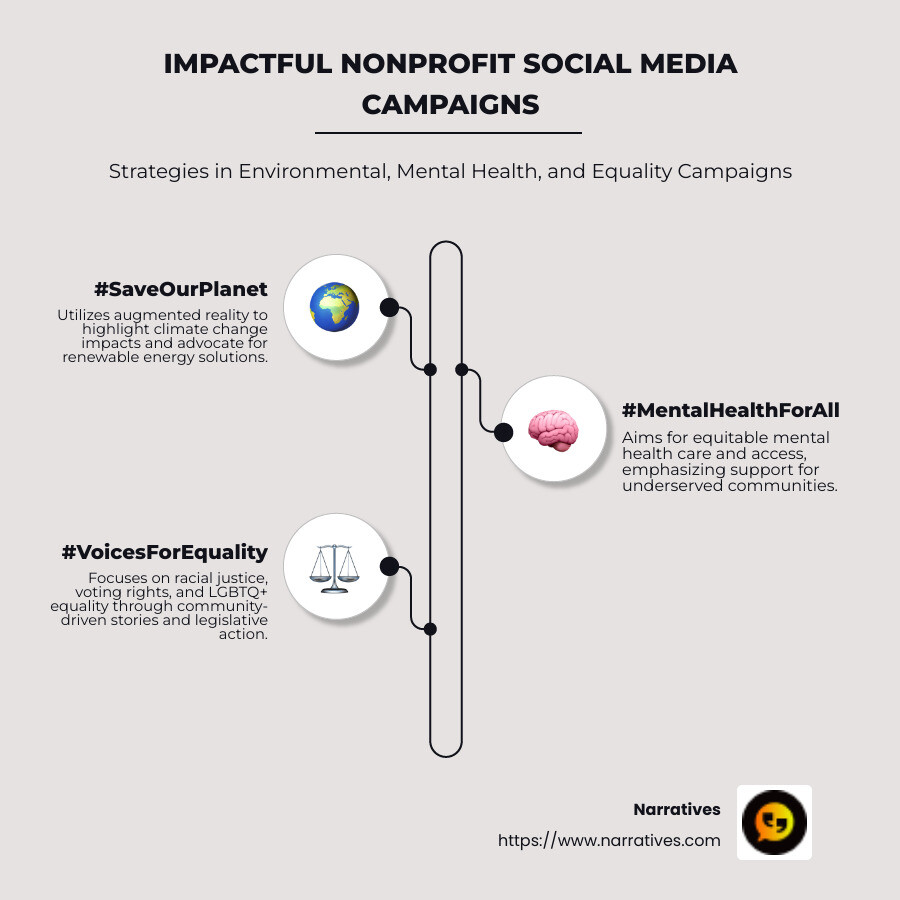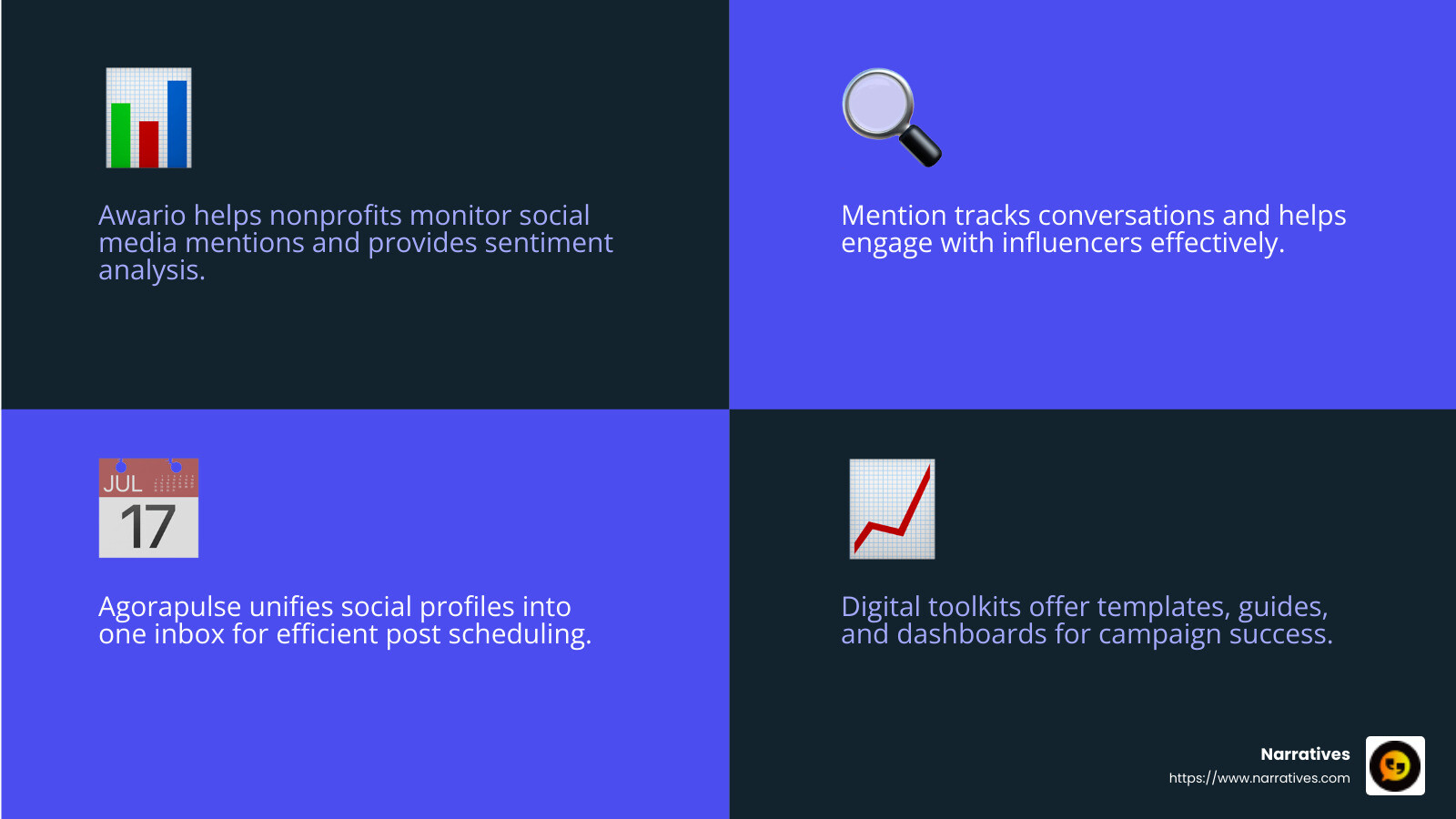Nonprofit Social Media Campaigns That Made Waves

Best nonprofit social media campaigns have significantly influenced public awareness and action through innovative strategies. Some noteworthy examples include:
- #SaveOurPlanet by Greenpeace: Highlights climate change impacts using augmented reality and calls for renewable energy solutions.
- #MentalHealthForAll by NAMI: Focuses on equitable mental health care and access, especially in underserved communities.
- #VoicesForEquality by ACLU: Advocates for racial justice, voting rights, and LGBTQ+ equality, emphasizing community-driven stories and legislative action.
Embracing Digital Strategies and Storytelling
In the digital world, nonprofits are creatively breaking new ground. This year, their campaigns stand out for how they combine innovative digital strategies with compelling storytelling to engage diverse audiences and drive meaningful change. From environmental advocacy to mental health and civil rights, these campaigns use platforms like social media to spread their messages effectively.
Through digital tools, nonprofits can turn complex global issues into relatable stories. Platforms like Facebook, Twitter, and YouTube have become crucial, allowing organizations like Greenpeace, NAMI, and the ACLU to reach and engage millions. These campaigns often involve vivid narratives and interactive elements that not only inform but inspire action.
The power of storytelling in nonprofit campaigns shines when personal stories connect with broader social issues. Nonprofits use these tales to create emotional resonance, compelling people to support their causes.
Nonprofits are not just raising awareness; they're also bridging gaps in understanding by directly connecting with supporters. This approach helps them achieve measurable results through community growth and increased involvement in their missions.

Best Nonprofit Social Media Campaigns
Nonprofits have harnessed the power of social media to launch some of the best nonprofit social media campaigns. These campaigns not only raise awareness but also drive action and foster community engagement. Let's explore a few standout examples:
Movember: Growing Awareness for Men's Health
Every November, men around the world grow mustaches to spark conversations about men's health issues, such as prostate cancer and mental health. The Movember campaign is a brilliant example of using humor and personal commitment to engage people. Participants create fundraising pages and share their mustache-growing progress on social media, encouraging donations and awareness.
Impact: Since its inception, Movember has raised over $1 billion, funding more than 1,250 men's health projects globally. This campaign's success lies in its community-driven approach and the use of social media to amplify its reach.
#SaveOurPlanet: A Call to Action by Greenpeace
Greenpeace's #SaveOurPlanet campaign is a powerful movement for climate justice and biodiversity conservation. By leveraging augmented reality, Greenpeace shows the real-time impact of climate change in users' local areas. This innovative use of technology engages audiences by making the issue personal and urgent.
Highlights:
- Augmented reality experiences
- Youth engagement through social media
- Partnerships with local NGOs
The campaign integrates grassroots mobilization, urging both policymakers and the public to take action against fossil fuel projects and accept renewable energy solutions.
#MentalHealthForAll: NAMI's Push for Equitable Care
The National Alliance on Mental Illness (NAMI) has been a leading voice in mental health advocacy. Their #MentalHealthForAll campaign emphasizes the need for equitable mental health care, especially for marginalized communities. Through survivor stories and social media engagement, NAMI breaks down barriers and reduces stigma.
Key Elements:
- Digital toolkits for community advocacy
- Influencer partnerships to reach younger audiences
- Focus on equity and inclusion
By sharing personal stories and using digital platforms, NAMI creates a supportive community that encourages open discussions about mental health.
These campaigns exemplify how nonprofits can use digital strategies and storytelling to connect with audiences and drive social change. By tapping into the emotional power of personal stories and leveraging technology, these organizations inspire action and foster a sense of community around their causes.
Top 6 Nonprofit Campaigns of 2024
In 2024, several nonprofit campaigns have made significant impacts through creative use of social media and digital tools. These efforts highlight how nonprofits can effectively engage audiences and drive meaningful change.
Greenpeace: #SaveOurPlanet
Greenpeace has always been a leader in environmental advocacy. In 2024, their #SaveOurPlanet campaign took a fresh approach by focusing on climate justice and biodiversity. The campaign used augmented reality to demonstrate the immediate effects of climate change in local areas, making the issue both personal and urgent.
Highlights:
- Interactive AR experiences
- Youth-focused social media content
- Collaborations with regional NGOs
By integrating grassroots mobilization and targeting policymakers, Greenpeace successfully engaged communities worldwide to advocate for renewable energy and against fossil fuel projects.
NAMI: #MentalHealthForAll
The National Alliance on Mental Illness (NAMI) continued to champion mental health awareness with their #MentalHealthForAll campaign. This initiative aims to improve access to mental health services, particularly for marginalized groups.
Key Features:
- Digital toolkits for legislative advocacy
- Influencer and celebrity collaborations
- Emphasis on equity and inclusion
Through powerful storytelling and digital engagement, NAMI has fostered a supportive online community that encourages open conversations about mental health.
ACLU: #VoicesForEquality
The American Civil Liberties Union (ACLU) has been a steadfast advocate for civil rights. Their #VoicesForEquality campaign in 2024 focused on racial justice, voting rights, and LGBTQ+ equality. The campaign featured impactful video testimonials and digital storytelling to amplify marginalized voices.
Strategies:
- Grassroots organizing and digital petitions
- In-person protests
- Legislative advocacy
By combining online and offline actions, the ACLU has been able to push for significant policy changes and raise awareness about systemic inequalities.
Feeding America: Hunger Action Month
Feeding America tackled food insecurity with their Hunger Action Month campaign. This initiative encouraged community participation through social media challenges and fundraising events.
Tactics:
- Social media challenges to raise awareness
- Partnerships with local food banks
- Community-driven fundraising events
By engaging supporters at the local level, Feeding America effectively highlighted the urgent need to address hunger in communities across the nation.
Code for America: Brigade Network
Code for America empowered civic engagement through their Brigade Network. This campaign mobilized volunteers to use technology for social good, addressing issues like access to public services and transparency in government.
Components:
- Volunteer-driven tech projects
- Localized community events
- Open-source tools and resources
By using the power of technology and community collaboration, Code for America has made a significant impact on civic participation and public service delivery.
World Central Kitchen: #ChefsForPuertoRico
World Central Kitchen continued their mission to provide meals in disaster-stricken areas with the #ChefsForPuertoRico campaign. This initiative focused on delivering food to those affected by natural disasters in Puerto Rico.
Elements:
- Mobilization of local chefs and volunteers
- Use of social media to raise awareness and funds
- Collaboration with local organizations
Through this campaign, World Central Kitchen has demonstrated the power of community and collaboration in providing immediate relief and support in times of crisis.
These standout campaigns of 2024 showcase how nonprofits can leverage digital platforms and community engagement to drive change and raise awareness for their causes. By using innovative strategies and storytelling, these organizations have successfully connected with audiences and inspired action.
How to Execute a Successful Nonprofit Social Media Campaign
Executing a successful nonprofit social media campaign requires a blend of strategy, creativity, and community focus. Here’s how nonprofits can leverage these elements to make an impact.
Active Platforms
Choosing the right platforms is crucial. Nonprofits should focus on where their audience is most engaged. Facebook, Twitter, and YouTube are among the top choices for nonprofits due to their broad reach and engagement capabilities. These platforms allow for diverse content types, from live videos to interactive posts, which can help amplify a campaign's message.
Storytelling
Storytelling is the heart of any effective nonprofit campaign. It transforms data and statistics into relatable narratives that resonate with audiences. For instance, the Movember campaign successfully uses personal stories to raise awareness about men's health issues. By encouraging men to share their journeys and grow mustaches, Movember combines humor and personal commitment to create a memorable and engaging campaign.
Key Storytelling Elements:
- Authenticity: Share real stories from those impacted by your cause.
- Visuals: Use compelling images and videos to improve the narrative.
- Emotion: Connect with your audience on an emotional level to inspire action.
Community Engagement
Building and nurturing a community is essential for sustained campaign success. Engaging with your community means more than just posting content; it involves listening, responding, and encouraging participation.
Strategies for Community Engagement:
- Interactive Content: Use polls, Q&A sessions, and live events to encourage participation.
- Peer-to-Peer Models: Empower supporters to fundraise and advocate within their networks, as seen in the Movember campaign.
- Recognition: Acknowledge and celebrate your community’s contributions, fostering a sense of belonging and motivation.
By focusing on active platforms, compelling storytelling, and robust community engagement, nonprofits can execute social media campaigns that resonate, inspire, and drive real change.
Tools and Strategies for Nonprofit Social Media Success
To run the best nonprofit social media campaigns, nonprofits need the right tools and strategies. Here’s how to get started.
Social Media Tools
Social media tools can make managing campaigns easier and more effective. They help track engagement, schedule posts, and gather insights. Here are some useful tools:
Awario: This tool monitors social media mentions and provides valuable insights like sentiment and reach. It helps nonprofits understand their online presence and find potential supporters.
Mention: With Mention, nonprofits can track conversations around their cause and engage with influencers. It's great for identifying trends and creating engaging content.
Agorapulse: This app combines all social profiles into one inbox, making it easy to manage and schedule posts. It also helps identify trends and audience sentiment.
These tools often offer discounts for nonprofits, making them accessible even for organizations with limited budgets.
Digital Toolkits
A digital toolkit is a collection of resources that help nonprofits create and manage their social media campaigns. This can include templates for posts, guides for best practices, and analytics dashboards.
Templates: Provide consistency in branding and messaging across platforms.
Guides: Offer step-by-step instructions on how to set up and run campaigns, including tips on timing and content types.
Analytics Dashboards: Help track the success of campaigns and adjust strategies based on data.

Partnerships
Collaborating with other organizations or influencers can significantly boost a campaign's reach and impact. Partnerships can take many forms:
Corporate Partnerships: Companies like Best Buy and Target have partnered with nonprofits to promote campaigns, encouraging donations at checkout. This extends the campaign’s reach and credibility.
Influencer Collaborations: Influencers can amplify a campaign by sharing it with their followers, bringing in new supporters.
Community Collaborations: Working with local groups can improve grassroots efforts and make campaigns more relatable to specific audiences.
By utilizing these tools and strategies, nonprofits can improve their social media presence, engage with their community, and drive meaningful change.
Frequently Asked Questions about Nonprofit Social Media Campaigns
What are the most effective platforms for nonprofits?
When it comes to reaching supporters, Facebook, Twitter, and YouTube are top choices for nonprofits.
Facebook is great for building communities and sharing detailed stories about your cause. It allows for direct engagement through comments and messages, helping nonprofits connect personally with their audience.
Twitter is perfect for quick updates and joining conversations. It's effective for spreading awareness and using hashtags to join global discussions. For example, the #SaveOurPlanet campaign used Twitter to engage users worldwide in climate change conversations.
YouTube is ideal for storytelling through video. It offers a platform to showcase the impact of a nonprofit's work visually. Videos can be powerful, as seen with campaigns like Charity: Water, which uses high-quality videos to connect emotionally with viewers.
How can nonprofits use social media for fundraising?
Social media is a powerful tool for fundraising. Here's how nonprofits can leverage it:
Donor Engagement: Engaging with donors online builds relationships. Sharing success stories and updates keeps supporters informed and involved. Nonprofits can use platforms like Facebook to thank donors publicly, creating a sense of community.
Peer-to-Peer Models: Encourage supporters to fundraise on behalf of the nonprofit. Campaigns like Movember show how effective this can be. Participants grow mustaches and use their networks to raise funds for men's health issues.
Fundraising Events: Use social media to promote virtual or in-person events. Platforms like YouTube can live-stream events, reaching a wider audience and encouraging real-time donations.
What are some examples of viral nonprofit campaigns?
Several nonprofit campaigns have gone viral, making significant impacts:
Movember: This campaign takes place every November, encouraging men to grow mustaches to raise awareness and funds for men's health. It has raised over $1 billion since its inception, thanks to its engaging and shareable format.
#SaveOurPlanet: Focused on climate change, this campaign used social media to rally global support. It leveraged hashtags to connect people and share information about environmental actions.
These campaigns highlight the potential of social media to amplify a cause and engage a global audience. By using creative strategies and engaging content, nonprofits can create campaigns that not only raise funds but also inspire action.
Conclusion
In nonprofits, digital storytelling is not just a trend—it's a necessity. The most impactful campaigns are those that tell compelling stories and connect with audiences on a personal level. At Narratives, we believe in the power of community-driven storytelling to lift underrepresented voices and drive meaningful change.
Narratives is committed to helping nonprofits harness the power of storytelling. By focusing on emotionally resonant multimedia content, we enable organizations to share their impact stories in a way that inspires action and builds trust.
Whether it's through high-quality videos, engaging social media campaigns, or interactive digital tools, the goal is to create content that resonates. This approach not only increases visibility but also fosters a sense of community among supporters.
The success of campaigns like #SaveOurPlanet and Movember shows us that when nonprofits effectively use social media, they can reach a global audience and inspire action on a massive scale. By telling stories that matter and engaging communities worldwide, nonprofits can create lasting impact.
If you're a nonprofit looking to lift your storytelling and connect with your audience, we invite you to explore how Narratives can be your partner in this journey. Together, we can make waves in the digital space and drive the change you envision.
Find how Narratives can help your organization shine through digital storytelling.


